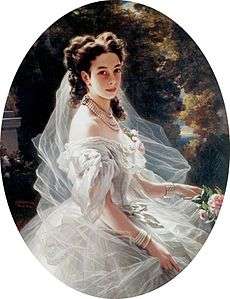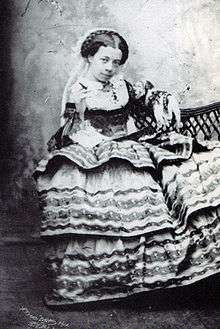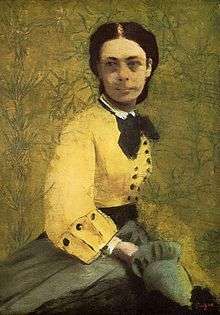Pauline von Metternich
| Princess Pauline | |
|---|---|
| Princess von Metternich | |
 | |
| Born |
25 February 1836 Vienna, Austrian Empire |
| Died |
28 September 1921 (aged 85) Vienna, Republic of Austria |
| Spouse | Richard Klemens, Prince von Metternich |
| Issue |
Princess Sophie von Metternich Countess Pascalina Antoinette von Metternich - Sandor Winneburg Countess Klementina Marie von Metternich - Sandor Winneburg |
| Father | Count Moritz Sándor |
| Mother | Leontine von Metternich |
Princess Pauline Clémentine von Metternich - Winneburg zu Beilstein née Countess Pauline Clémentine Marie Walburga Sándor de Szlavnicza (25 February 1836 in Vienna – 28 September 1921 in Vienna) was a famous Viennese and Parisian socialite of great charm and elegance. She was an important promoter of the work of the German composer Richard Wagner and the Czech composer Bedřich Smetana. She was also instrumental to the creation of the haute couture industry.[1]
Life



Princess Pauline von Metternich (also known as "de Metternich" and "von Metternich-Winneburg") was born into the Hungarian noble family of Sándor de Slawnitza. Her father, Moritz Sándor, described as "a furious rider", was known throughout the Habsburg empire as a passionate horseman. Her mother, Princess Leontine von Metternich, was a daughter of the Austrian chancellor Prince Klemens Wenzel von Metternich (architect of the Concert of Europe). It was at his home in Vienna that Pauline spent almost her whole childhood.
In 1856, she married her uncle, Prince Richard von Metternich, a son of chancellor Prince Klemens Wenzel von Metternich.[2] They lived a happy conjugal life, despite his frequent love-affairs with actresses and opera prima donnas, and had three daughters.
Pauline accompanied her husband, an Austrian diplomat, on his missions to the royal court in Dresden and then the imperial court in Paris, where they lived for almost eleven years (1859 to 1870). She played an important role in the social and cultural life of Dresden and Paris, and, after 1870, Vienna. She was a close friend and confidante of French Empress Eugénie, and, with her husband, was a prominent personality at the court of Emperor Napoleon III. She introduced fashion designer Charles Frederick Worth to the Empress and thus started his rise to fame.
Pauline was an ardent patron of music, and became a leader of fashionable society. Whether in Paris or Vienna, she set the latest social trends. She taught French and Czech aristocrats to skate, and ladies to smoke cigars without fear of their reputations. She was acquainted with many composers and writers, including Richard Wagner, Franz Liszt, Charles Gounod, Camille Saint-Saëns, Prosper Mérimée and Alexandre Dumas), and corresponded with them. She was an advocate for the music of Wagner in Paris and Czech music composer Bedřich Smetana in Vienna. She organised salon performances of abridged versions of many famous operas, including Richard Wagner's Der Ring des Nibelungen, in which she took part both as a stage director and singer.
In her private life, Pauline suffered several crises and disasters. As a child, she was an eyewitness to the revolution of 1848 in Vienna. In 1870 she remained at the side of Empress Eugénie in Paris during the Franco-Prussian War. Later she aided the Empress' escape from Paris to Great Britain by secretly sending Eugénie's jewels to London in a diplomatic bag.
Pauline's first child was Sophie (1857–1941); her second daughter, Pascaline (b. 1862), married Count George of 'Waldstein', an insane and alcoholic Czech aristocrat who was said to have murdered her in delirium in Duchcov (today in the Czech Republic) in 1890. Her youngest daughter, Clementine (b. 1870), was badly injured by her dog as a child and decided never to marry due to her scarred face.
Princess Pauline died in Vienna in 1921. She lived through the glory and fall of the Austrian and French empires and was believed to be a living symbol of these two lost worlds.
A portrait of her by French impressionist Edgar Degas, painted from a photograph, now hangs in the National Gallery, London.
Famous duel
In August 1892, Pauline participated in an emancipated duel with Countess Anastasia Kielmannsegg, with the Princess Schwarzenberg and Countess Kinsky as seconds, and Baroness Lubinska who had a degree in medicine provided medical assistance. It was Lubinska who insisted they fight topless. She was concerned that if a bit of clothing jammed into a wound, it could become infected and sepsis would set in. So the ladies removed their blouses and the duel commenced. Abiding by French rules, they would duel to the blood, using rapiers. Pauline was slightly wounded on the nose, while the countess was wounded in the arm. Some articles report Anastasia the winner, drawing first blood, while others consider Pauline the victor, since her stab to the arm was the better wound.[3] The cause of the duel is reputed to be an argument over flower arrangements for the Vienna Musical and Theatrical Exhibition.[4][5][6]It was highly unusual for women to be dueling, let alone bare-chested, so it's no wonder that this topless duel made headlines around the world. This was the first-ever "emancipated duel" that involved not only all female participants, but all female "seconds", as well a female medic.
Legacy
Princess Pauline was a notable patron of contemporary arts. She befriended music composers Richard Wagner (who dedicated a piano composition to her) and Franz Liszt, and helped them. She also organised the Parisian première of Wagner's opera Tannhäuser in 1861. The project failed (it closed after three performances) and became a celebrated fiasco and one of the greatest music-related scandals of the nineteenth century. Nevertheless, Pauline continued to spread the music of Wagner and other now-famous composers. One of her protégés was the leading Czech musician of that time, Bedřich Smetana, whom she introduced to the music circles of Vienna and Paris. Thanks to Pauline, Smetana's comic opera The Bartered Bride was produced in Vienna in 1892, to popular acclaim.
Pauline's regular travels between, and extended stays in, Paris and Vienna, permitted her to act as a cross-cultural transmitter of the many trends that interested her in music, political ideas, and sport.
She wrote two books of memoirs. The first, Gesehenes, geschehenes, erlebtes, in German, honored her grandfather, Chancellor Metternich, and father, Count Moritz Sándor, and the second, Éclairs du passé, in French, recalled her life and times in the court of Emperor Napoleon III and Empress Eugénie. Both were published posthumously in the 1920s.
Issue
Richard and Pauline von Metternich had three children :
- Princess Sophie von Metternich (1857–1941)
- Countess Pascalina Antoinette von Metternich-Sandor Winneburg (1862–1890)
- Countess Klementina Marie von Metternich-Sandor Winneburg (1870-1963)
Since the marriage produced no sons, Richard's title of "Prince von Metternich" passed to his half-brother, Paul von Metternich.
Memoirs
- Pauline Clementine Marie Walburga (Sándor von Szlavnicza), Fürstin von Metternich-Winneburg. The Days That Are No More: Some Reminiscences. E. Nash & Grayson, London (1921). ASIN B000881512
- Pauline Clementine Marie Walburga (Sándor von Szlavnicza), Fürstin von Metternich-Winneburg. My Years in Paris. E. Nash & Grayson, London (1922). ASIN B00085ZS7W
Literature
- Octave Aubry, L'Impératrice Eugénie, Paris 1937.
- Jules Gesztesi, Pauline Metternich. Ambassadrice aux Tuileries, Paris 1947.
- Theophila Wassilko, Fürstin Pauline Metternich, Munich 1959.
- Brigitte Hamann, Elisabeth. Kaiserin wider Willen, Vienna 1982.
External links
| Wikimedia Commons has media related to Princess Pauline de Metternich. |
- Sándor family (Hungarian: hu:Sándor család
- ↑ http://www.fashionintime.org/history-haute-couture-first-couturier/
- ↑ Paulina Sandor at thePeerage.com http://www.thepeerage.com/p44523.htm#i445229
- ↑ http://jenniwiltz.com/the-dueling-princess-pauline-metternich/
- ↑ Baldick, Robert (1996). The Duel: A History. United States of America: Barnes & Noble Books. p. 177. ISBN 0-7607-0131-8.
- ↑ Thimm, Carl Albert (1896). A Complete Bibliography of Fencing & Duelling: As Practised by All European Nations from the Middle Ages to the Present Day. London & New York: John Lane (via Google Books). p. 492.
- ↑ "Papers Past". Ashburton Guardian. Volume XIV (Issue 2799). 14 October 1892. p. 2. Retrieved 3 September 2013.